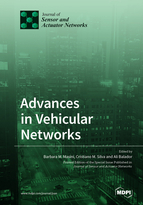Advances in Vehicular Networks
A special issue of Journal of Sensor and Actuator Networks (ISSN 2224-2708). This special issue belongs to the section "Network Services and Applications".
Deadline for manuscript submissions: closed (30 June 2020) | Viewed by 41032
Special Issue Editors
2. Department of Electrical, University of Bologna, 40136 Bologna, Italy
Interests: connected vehicles; Internet of vehicles (IoV); relay-assisted communications; visible light communication (VLC); 5G
Special Issues, Collections and Topics in MDPI journals
Interests: mobile networks; connected vehicles; roadside communication infrastructure
Special Issue Information
Dear Colleagues,
Vehicle-to-anything (V2X) communication is a key asset of the next automation revolution, representing the core of major transformations in society with social, economic, and environmental impacts. Connected vehicles are expected to transform the way we travel and how we live, through the creation of a safe, interoperable wireless communication network among road actors, infrastructure, and objects. Combined with sensor-based technologies, connected vehicles will enhance the performance of automated driving and increase further traffic safety. International consortiums have already agreed on the basic set of applications that need to be implemented to start operating a vehicular network infrastructure at a large scale. Current access technologies, such as IEEE 802.11p or 3GPP LTE-V2X can already succeed in providing challenging new applications, but cannot satisfy all requirements of future applications, since these technologies are designed with the human user in mind; hence, with latency in the order of hundred milliseconds, around 90% of reliability within given ranges, and limited data rates. The fully connected car will require a massive amount of computing power and super-high-speed communications systems such as 5G V2X.
This Special Issue is seeking original contributions on vehicular networks, sharing the research efforts and deployment challenges in this field and discussing challenges, key enabling techniques, unprecedented approaches, and field trails.
Prof. Dr. Barbara Mavì Masini
Dr. Cristiano M. Silva
Dr. Ali Balador
Guest Editors
Manuscript Submission Information
Manuscripts should be submitted online at www.mdpi.com by registering and logging in to this website. Once you are registered, click here to go to the submission form. Manuscripts can be submitted until the deadline. All submissions that pass pre-check are peer-reviewed. Accepted papers will be published continuously in the journal (as soon as accepted) and will be listed together on the special issue website. Research articles, review articles as well as short communications are invited. For planned papers, a title and short abstract (about 100 words) can be sent to the Editorial Office for announcement on this website.
Submitted manuscripts should not have been published previously, nor be under consideration for publication elsewhere (except conference proceedings papers). All manuscripts are thoroughly refereed through a single-blind peer-review process. A guide for authors and other relevant information for submission of manuscripts is available on the Instructions for Authors page. Journal of Sensor and Actuator Networks is an international peer-reviewed open access semimonthly journal published by MDPI.
Please visit the Instructions for Authors page before submitting a manuscript. The Article Processing Charge (APC) for publication in this open access journal is 2000 CHF (Swiss Francs). Submitted papers should be well formatted and use good English. Authors may use MDPI's English editing service prior to publication or during author revisions.
Keywords
- Cellular-V2X (C-V2X) as the road to 5G vehicular networks
- IEEE 802.11px vs. LTE-V2X
- Hybrid vehicular networks
- Efficient handling of huge numbers of vehicular users
- V2V communications for extended network coverage and reduced end-to-end latency
- V2V networks as fall back solutions in the absence of the infrastructure
- Resource allocation and optimization for V2X
- Automotive and telecom industry steps and benefits
- Connected autonomous vehicles
- Field operational tests and trials.
- Blockchain for vehicles
- Artificial Intelligence applied to smart transportation
- Strategies for managing vehicular networks
- Big data in intelligent transportation systems
- Platooning applications
- Security and privacy
- Fog/edge computing for connected vehicles
- Machine learning and deep learning for intelligent vehicular networks








